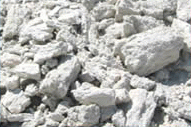What is the Sorbite Humidity Control System?
1)
Sorbite™, a brief history2)
Properties of Sorbite™3)
Product Safety4)
Packaging and InstallationAt the heart of the humidity control system is the mineral, Sorbite™. The mineral was discovered in 1952 by an errant prospector when while roaming the Mohave Desert, came upon a human corpse lying face down on the ground. What caught his attention was that wherever the flesh came in contact with the ground, there appeared to be no deterioration. The authorities matched the body to a person who had been missing for over a month and the autopsy confirmed that the body had been dead for about ten days. The Medical Examiner who performed the autopsy was likewise confounded by the parts of the body that had not deteriorated. The doctor solicited a scientist colleague to investigate this strange phenomenon. They returned to the site where the body was found and brought back a large sample of the mineral.
The doctor and the scientist performed several experiments on the mineral. When they discovered its unique ability to absorb and desorb large amounts of water vapor, it was dubbed Sorbite™. They also determined that when in an enclosed space, the mineral reached maximum saturation at a temperature just above freezing. Furthermore, the relative humidity in the test enclosure stabilized near 80%, until the mineral saturated. Unfortunately for them, they did not see any commercial applications for Sorbite™ and quickly lost interest.
Sorbite™ would have been lost in obscurity, had it not been for the real hero of our story. Some twenty years later, the son of the scientist, was going through his father's possessions after his death, and found a box with about ten pounds Sorbite™ and a notebook. The notebook contained the details on the discovery and experiments conducted on the mineral. The son, having worked in a restaurant during his college days immediately saw the potential of Sorbite™. He crushed the rock into pieces about ¼" in diameter, put two pounds in a bag he made of cheesecloth, and supported the bag in a frame using chicken wire. He then put several of these "panels" in a walk-in cooler and as they say, "the rest is history".

The primary property of Sorbite™ is its unique ability to absorb and desorb moisture in the form of water vapor. The amount of water absorbed is dependant on the vapor temperature and the level of saturation. The mineral is capable of this with other vapors as well. The real beauty of this is when the mineral is used in a closed volume with temperatures just above freezing. Under these conditions Sorbite™ acts as a buffer holding the relative humidity in 80% range. The mineral also displays this property with other vapors to various degrees depending on the specific molecule, temperature, and the presence of other vaporous compounds in the air. Exhaustive test were done on Sorbite™ by Jeffrey Nelson at the Rockwell Science Center in Thousand Oaks, CA. (View test summary). According to the report, Sorbite™ will saturate with moisture at 48% of its weight at 2° C. The total amount of moisture that can be absorbed decreases rapidly as the temperature rises and is nearly 0% at 60° C. Related to this is the rate at which the moisture is absorbed or desorbed. Although the report does not address this, the rate of absorption was measured at 2° C to be about 200 mg. of moisture per Kg. of dry Sorbite™ per minute and asymptotically approaches 0 mg./Kg./minute as the mineral saturates. Of course, the desorbtion rate is the inverse of this. This data and some math were used to determine how to maximize the benefits and efficiency of Sorbite™ in enclosed refrigerated systems.
Sorbite™ has been tested to be non-toxic. While the USDA, FDA, or OSHA does not formally "approve" the use of Sorbite™ (or any other product), it is clear from their letters that these agency have no objections to its use.

The panels for the Sorbite™ system were designed with two important requirements; safety and product efficiency. The mineral is ground into pellets about 75mm in diameter. The plastic used is medically safe (no out gassing) and lightweight. The bags containing the mineral are made of a polypropylene laminate (2-ply) filter material used in the medical industry which allows for unrestricted airflow while ensuring complete containment of Sorbite™. The panel configuration is designed to maximize the airflow and exposed surface area of Sorbite™. The panels are installed with galvanized 'T" bracket which suspends the panel horizontally from the ceiling. The design of the bracket ensures maximum airflow, safety, and ease of service. In addtion to the panels used in walk-in coolers, we also have smaller panels for reach-in and display coolers.



